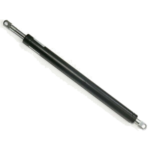Technology | Gas Spring | History | Forces | Nitrogen & Oil | Instructions | Disposal
How to remove Gas Springs :
Gas springs and dampers are wear products and must therefore be replaced depending on the load and area of application if they no longer perform.
 It is not possible to reprocess gas springs.
It is not possible to reprocess gas springs.
Gas springs are mainly made of metal and can be recycled. Gas springs must be depressurized beforehand, and the oil must be drained and disposed of separately.
When disposing of gas springs, we always ask you to note that they can still be under high pressure.
The following work must be carried out taking into account the accident prevention and environmental protection regulations:
1: Clamp the cylinder of the gas spring or damper firmly in the vice without deforming it.
2: Drill or saw into the cylinders of the gas spring approx. 25mm from the cylinder bottom (drill bit diameter 2-3 mm). Due to the high internal pressure, chips and oil can spray away. Take appropriate measures to protect the person (eye and face protection, covering the drill hole or the sawing point). No one may stand in the area of the extended device axis. The piston rod must therefore not point to people when releasing pressure. Do not cut ends. Never use a lathe! The gas spring is only depressurized when the piston rod can be freely moved back and forth by hand. If the piston rod cannot be moved, another hole should be drilled approx. 30 mm from the guide side (opposite side).
3: By repeatedly moving the piston rod back and forth, the oil is pumped through the hole in the gas spring.
4: If necessary, the cylinder can now be sawn through.
Disposal only through the raw material trade or a special waste collection point. Do not put parts in the household waste. Oil must not get into the ground or into water.
If this regulation cannot be met, we recommend – after consultation – returning the goods to the supplier free of shipping costs. Disposal takes place at cost price.
